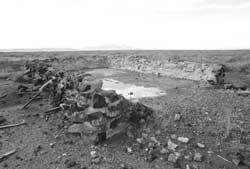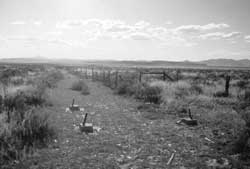MENU
|
| |
Confinement and Ethnicity: An Overview of World War II Japanese American Relocation Sites by J. Burton, M. Farrell, F. Lord, and R. Lord |

|
|
| |
Chapter 12 (continued)
Topaz Relocation Center
Security Features
Recently constructed ramps in the northeast portion of the central area has caused extensive disturbance to the military police compound. Very little remains there besides three small concrete slabs, one recently modified by a crude rock and concrete wall (Figure 12.24).
 Figure 12.24. Rock and concrete wall at the military police compound. |
 Figure 12.25. Watch tower foundation and intact portion of the western perimeter fence. |
On the west, south, and east sides of the relocation center, portions of the perimeter security fence still remain. Foundations of three of the seven watch towers are still in place (Figure 12.25). At the location of two of the other watch towers, the foundations, though pulled out of place, are nearby. Eight other likely watch tower foundation remnants (large formed-in-place concrete blocks) have been used to make a low wall at the driveway entrance to Mr. Williams's home in Block 28.
 Top
Top
Last Modified: Fri, Sep 1 2000 07:08:48 pm PDT
http://www.cr.nps.gov/history/online_books/anthropology74/ce12c.htm
![]()

